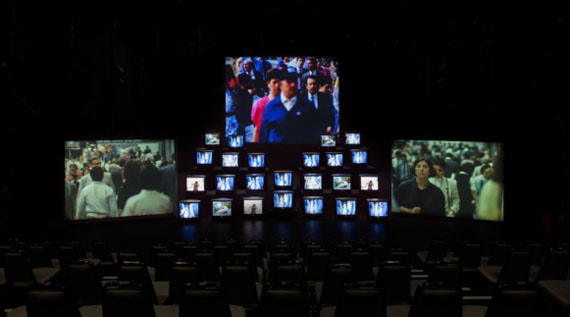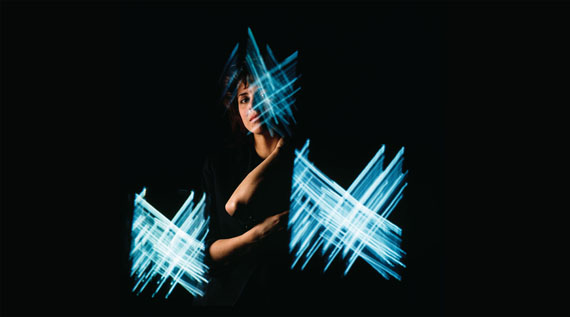
Gretchen Bender »
So Much Deathless
Exhibition: 6 Mar – 28 Jul 2019

Red Bull Arts New York
220 w 18th Street
NY 10011 New York
+1-212-379-9417
redbullartsny@us.redbull.com
redbullarts.com
Wed-Sun 12-19

Red Bull Arts New York is proud to present Gretchen Bender: So Much Deathless, the first posthumous retrospective of the life and work of the influential, multi-disciplinary artist. Opening to the public on March 6, 2019, and remaining on view until July 28, the ambitious exhibition returns the spotlight to one of contemporary art’s most prescient figures, detailing her historic importance and contemporary relevance.
Gretchen Bender (1951-2004) was a pioneering artist who worked across video, sculpture, computer graphics, photography, print and installation to interrogate the accelerated age of mass media. Moving to New York in 1978, Bender quickly fell in with the Post-Pictures Generation scene, centered around the artist-run gallery Nature Morte, as well as a milieu of artist and performers connected to The Kitchen. She befriended and collaborated with such figures as artists Robert Longo and Cindy Sherman, the choreographers Bill T. Jones and Arnie Zane, and musicians Stuart Argabright and Vernon Reid. Building upon techniques developed in her years running a feminist-Marxist screen-printing collective in Washington, D.C., Bender’s early two-dimensional work, made in New York, abstracted and juxtaposed images appropriated from across the visual spectrum: from other artists, the news cycle, and corporate and military advertising. The effect was a disturbing barrage that spoke to the accelerating power of the image in the coming digital age.
Bender’s later shift to moving-image work, first with single-channel videos, and then with her immersive “electronic theatre” projects—massive installations such as the 13-monitor, 4-channel Dumping Core (1984), and the 24-monitor, 3-projection, 8-channel Total Recall (1987)—predict the near totalizing image-saturation of the coming decades, and find the artist further infiltrating modes of cultural transmission. Bender understood society to be on the precipice of a vast change, with the technologically mediated image less a warning sign than a guide. Speaking to this complicated dialectic between critique and embrace, alongside her art practice, Bender went a step further into subverting and infiltrating mainstream media platforms through her hired commercial work, including the now-iconic intro sequence for America’s Most Wanted, and developing music videos, often in collaboration with Robert Longo, for bands like R.E.M., New Order, Megadeth, and Babes in Toyland.
“Gretchen Bender was the most radical, and perhaps the least known, of the Pictures Generation artists. Her engagements with moving images, the technologies of television, digital graphics, and other popular formats remain urgent and fresh, yet contemporary viewers have only had rare opportunities to see her works installed,” says Cay Sophie Rabinowitz, Representative of the Gretchen Bender Estate. “This retrospective, the first in nearly thirty years, presents Bender’s oeuvre as a whole. In particular the study and inclusion of archival material, and the careful restoration of certain media components have been vital to making this exhibition of Gretchen Bender’s work an exemplary accomplishment.”
When Bender died in 2004, at the age of 53, the media climate that she had long anticipated was well on its way to reality—a “cannibalistic river” and seamless totality of screens, social media, smartphones, visual and data-tracking surveillance, the melding of politics and entertainment, and fake news. Gretchen Bender: So Much Deathless serves as both critique and map of the contemporary landscape, a guide to how viewers might navigate through their world. Developed in close collaboration with the Gretchen Bender Estate, and bolstered by extensive oral histories with many of her notable peers and friends, the exhibition will include examples of every major body of work in Bender’s oeuvre, from her early photographic installations to the studies and archival material surrounding her magnum opus, which was to be entitled So Much Deathless, left unrealized due to her untimely death. The exhibition will also feature Bender’s monumental work of electronic theatre entitled Total Recall (1987), and artworks and videos that have not been exhibited since the 80s or 90s, newly restored by Red Bull Arts New York.
“Gretchen was a brave and uncompromising artist whose prophetic body of work feels like an urgent message from the past, yet somehow impossibly contemporary,” says Max Wolf, Chief Curator of Red Bull Arts New York. “With our program in its 5th year, it is an honor to be entrusted by the Estate of Gretchen Bender to organize this survey, which aims to shed light on her work’s historical significance, and establish a better understanding of her impact as an artist today.”
Public programs include an excerpt and reprisal of Bill T. Jones / Arnie Zane Company’s canonical work, Still/Here (1994), a performance which featured a video score and set design by Bender. On occasion of the piece’s 25th anniversary, Still/Here will be co-presented with New York Live Arts. Red Bull Arts New York will also present a live score of Bender’s largest work of “electronic theatre,” Total Recall (1987), performed by the original composer Stuart Argabright. Additional programs include exhibition tours, artist talks, film and video screenings, and collaborations with The New York Public Library for the Performing Arts.
ABOUT GRETCHEN BENDER
Gretchen Bender (1951- 2004) was an American artist who worked in video, sculpture, photography, print and installation. She received her BFA from the University of North Carolina at Chapel Hill in 1973, and came to prominence in the 1980s as a post-appropriation artist in the East Village. Bender showed at Nature Morte, Metro Pictures and International with Monument in New York, and Meyer/Bloom in Los Angeles. Her work was included in the historical show Infotainment in 1985 and has circulated widely in exhibitions at the New Museum; The Museum of Contemporary Art, Los Angeles; The Whitney Museum of American Art; Hammer Museum; Tate Liverpool; Museum of Contemporary Art Chicago; Institute of Contemporary Art, Boston; San Francisco Museum of Modern Art; Schinkel Pavillon, Berlin;, among others. In 2013, Gretchen Bender: Tracking the Thrill traveled from The Poor Farm in Wisconsin to The Kitchen in New York, effectively reintroducing Bender’s “electronic theater” piece Total Recall to the art world at large. Her work appears in the collections of The Art Institute of Chicago, Tate Modern, The Metropolitan Museum of Art, The Museum of Contemporary Art Los Angeles, The Museum of Modern Art, Centre Georges Pompidou, and the Menil Collection. Bender was the recipient of a New Genres Fellowship from the National Endowment for the Arts in 1985, a Bessie Award in 1995 for her visual concept and set design for Bill T. Jones / Arnie Zane Company’s Still/Here at BAM, an Anonymous Was A Woman award in 1997, and Art Matters Foundation fellowships in 1987 and 1997.
This exhibition contains graphic content, viewer discretion is advised. Visitors under the age of 18 must be accompanied by a parent or guardian.